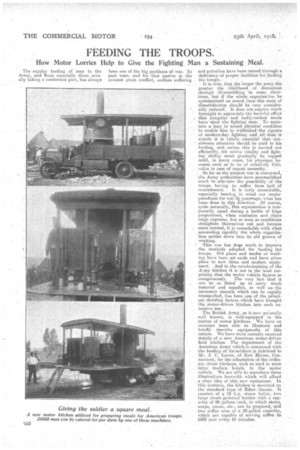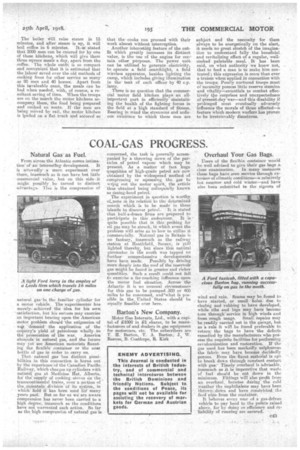FEEDING THE TROOPS.
Page 18

Page 19

If you've noticed an error in this article please click here to report it so we can fix it.
How Motor Lorries Help to Give the Fighting Man a Sustaining Meal.
The ,regular feeding of men in the Army, and tore especially those actnally taking a combatant part, has always been one of the big problems of war. In past wars, and for that matter in the present great conflict, endless suffering
and privation have been caused through a deficiency of proper facilities for feeding
the troops.
It is true,-that the larger the army the greater the likelihood., of discontent through . ill-nourishing in tome directions, lout if the whole organization be systematized op sound lines this state of dissatisfaction should be very considerably redueed. It does not'require much foresight to appreciate the harmful effect . that irregular and badly-cooked meals haVe Uponthe 'fightingman. To mainthin a nian in sound physical condition to enable' him to withstand-the rigmirs. of modern-day fighting and all that: itentails it is vitally. essential that -don, siderate attention should be paid to his feeding, and ,unless this is carried out. efficiently, his active vitality and fighting ability must gradually he sapped. until, in many cases, his physique becomes such as to be of relatively EWE
. value in case of urgent necessity-.
. So far as the present war is concerned, the Army authorities have accomplished much to alleviate the possibility of the troops having" to suffer from lack of
nourishment. It is truly remarkable, especially bearing in mind our unpreparedness for war 3i years•ago, -what has been -done in this direction. Of course, quite naturally:This organization is km, porarily upset during a battle of huge proportions, when confusion and chaos reign supreme, but so soon as conditions straighten themselves out and become more normal, it is remarkable with what astounding. rapidity the whole organization settles down into its old groove of
• working.
This war has dose much, to improve the methods ad-opted for feeding the troops. Old plans and modes of working have been set aside and have given place to new ideas and modern equipment. And in the reirolutionizing of the Army kitchen it is not in the least am'. prising that the motor vehicle figures so
-conspicuously. The very fact that it can be 'so fitted up to carry much material and supplies, as well as. the necessary utensils which can be rapidly transported, has been one of the principal deciding factors which have brought the--motor-driven kitchen into such extensive use.
The British Army, as is now generally well known, is well-equipped in the :matter of motor kitchens. We have on odcasion been able to illustrate and briefly describe equipmedts of this nature.. We have more recently received details of a new American motor-driven field kitchen. The department of the American Army which, is concerned with the feeding of its soldiers is indebted to -Mr. J. C. Laven, of New Haven, Connecticut, for the adaptation of the ordinary steam kitchens, such as used in most large modern hotels, to the motor vehicle. We are able to reproduce three . illustrations herewith which will afford a clear idea of this new equipment. iq this instance, the kitchen is mounted on the standard type of Hiker chassis. -It consists of a 15 h.p steam boiler, two large steam-jacketed kettles with a capacity of 90 gallons each, in which stews, soups, roasts, etc., can be prepared, a:Tid two coffee urns of a 50-gallon capacity, which are capable of serving .coffee to 1500 Men every-10 minutes. "
The boiler iill raise steam in 15 minutes, and after steam is up, it will
boil coffee in 6 minutes. stated that 2000 men can be catered for by one of these kitchens, which will give them three square meals a day, apart from the coffee. The whole outfit is so compact and convenient that it is estimated that the labour saved over the old methods of cooking frees for other service as many as 80 men and 90 horses. Apart from this iuvaluable asset, the meals can be had when needed, with, of course, a resultant saving of time. When the troops are on the -march the motor kitchens accompany them, the food being prepared and cooked en route. If the men are being mOved by rail, the meter kitchen is lparled on a flat track and seeured so
that the cooks can proceed with their work almost without interruption. Another interesting feature of the outfit which greatly increases its distinct value, is the use of the engine for certain other purposes. The power unit can be utilized to generate electricity, to operate a field searchlight, a field wireless apparatus, beside.s lighting the tamp, which includes giving illumination in the tent of each officer by 40 c.p. lamp.
There is no question that the commercial motor field kitchen plays an allimportant part in efficiently maintaining the health of the fighting forces in the field at a high standard of fitness. Bearing in mind the strenuous and arduous existience to which these men are eubject and the necessity for them always to be energetically on the alert, it needs no great stretch of the imagine.tien to understand fully the beneficial and revitalizing effect of a regular, .welleookecl palatable meal. It has been said, on what authority we knew not, that to feed a man is to make him contented; this expression is more than ever a truism when applied in connection with the troops. Poorly nurtured troops must of necessity possess little reserve stamina and vitality—essentials to combat effectively the surprises and unexpectedness of .present-day war—andthia disability if prolonged must eventually adversely influence the morale of those affected—a feature which modern warfare has proven to be irretrievably clisa.strous.






















